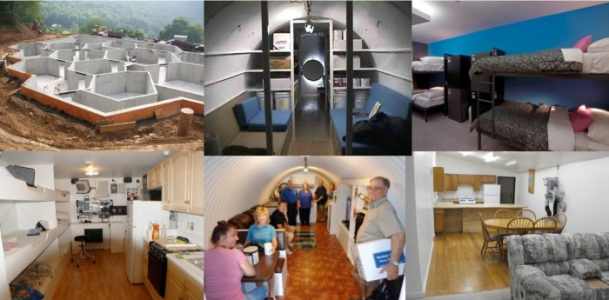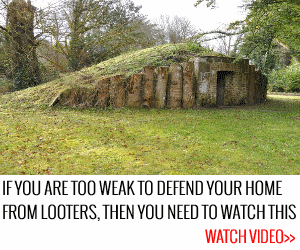 With real concerns about natural disasters, terrorism and riots, an increasing number of families are installing underground bunkers in their homes. However, not all underground shelters are the same. The materials and construction can vary considerably and if you build the wrong type – or leave out a vital element – then this could make all the difference to whether you and your family survive
With real concerns about natural disasters, terrorism and riots, an increasing number of families are installing underground bunkers in their homes. However, not all underground shelters are the same. The materials and construction can vary considerably and if you build the wrong type – or leave out a vital element – then this could make all the difference to whether you and your family survive
The best material for underground homes
The most reliable and resilient material for constructing an underground bunker is concrete.
Although some shelter companies may try to convince you that concrete is an inferior building material, the fact is that it is far superior to others in the shelter industry.
Historically, concrete has been used for many years as the material of choice for constructing many structures that come into contact with the earth. These include tunnels, bridges, skyscrapers and dams, as well as bunkers.
A concrete bunker has strength, resistance and durability
- Concrete is stronger than any other man-made construction material and provides unparalleled load bearing qualities as well as good resistance to impact, fire, corrosion and noise.
- When reinforced with steel, concrete is virtually indestructible and therefore an ideal choice for use as an underground bunker.
- Solid concrete has an ultimate compressive strength far greater than any other shelter material.
- It acts as a natural barrier between the occupant and the outside environment protecting them from direct and indirect impacts.
- Compared with a fibreglass shelter, a concrete bunker is more likely to protect your family from a direct impact than a fibreglass shelter will.
- Concrete is also preferable to fibreglass or steel because of its resistance to fire, extremes of temperature and weathering. A concrete doomsday bunker will be resistant to heat and freezing temperatures; thawing, water intrusion and corrosion.
- Concrete is maintenance free and long lasting – it ages well and can last for thousands of years.
- Concrete is eco friendly because it is made from a natural material base of sand and aggregate lime
Bunker design and construction
The honeycomb is well known for its six sided hexagonal shape, but many people are unaware of how clever the bees are to have created a highly efficient design. Structurally the honeycomb shape makes it an ideal choice for designing an underground doomsday bunker because it enables:
- the maximum amount of space with the minimum amount of material
- a strong structure
- excellent stability
Bunker Ventilation
A good ventilation filtration system is essential, especially If you are building a bomb shelter that needs to protect your family from any biological and chemical agents. Your ventilation system needs to
- filter out toxins
- vent cooking and sewage fumes
- have a ventilation pipe that is protected from the risk of falling ash, earth or snow and sabotage. A second back up ventilation pipe is recommended where possible.
Unless your bunker can supply plenty of fresh, clean air, you and your family will be at risk of becoming physically and emotionally unwell – particularly if you need to stay in the structure for a period of time.
Sanitation and waste disposal system
Since circumstances may prevent you from being able to step outside of your bunker for a number of days – or even weeks, good sanitation in the form of a septic tank system will need to be incorporated into any underground bunker project.
Heating and Lighting
For short term situations, large battery packs will be adequate for supplying heating and lighting. However, other forms of energy producing systems such as solar power or generators should be incorporated into your plans.
Location
There are a number of factors to be taken into account prior to installing an underground bunker:
- Check where the water table is in the area you plan to install your shelter – you don’t want your bunker filling up with water
- Avoid any construction near to trees as the roots may destabilize or destroy your building
- Security: Keep the location of your bunker secret
Emergency Essentials
Disaster preparedness means thinking about all the many things you will need if you have to stay in your underground bunker for a long period of time. These include:
- Adequate supplies of long life food and storage facilities
- A good water supply (in containers or a suitable filtration/purification system)
- Cooking equipment
- Washing and cleaning facilities
- Sleeping area – bunks/sleeping bags
- Communication equipment (non electric)
- Medical equipment
- Security equipment
- Entertainment –you’re going to get very bored if you’re holed up in your bunker for weeks without anything to pass the time
Summary
An increasing number of people have already constructed their own underground bunker.
Building your own shelter is possible but there are many factors that need to be taken into account before you attempt to do so. Constructing the wrong type of bunker; forgetting to install a vital element or building it in an inappropriate location may put yourself and your family at greater risk.
Unless you have relevant building experience, it is advisable to enlist the help of a building expert or alternatively, buy a purpose built underground bunker from a specialist company who can construct the best and safest type of shelter for your family’s needs.
Backyard Innovator (A Self Sustaining Source Of Fresh Meat,Vegetables And Clean Drinking Water)
Blackout USA (EMP survival and preparedness)
Conquering the coming collapse (Financial advice and preparedness )
Liberty Generator (Build and make your own energy source)
Backyard Liberty (Easy and cheap DIY Aquaponic system to grow your organic and living food bank)
Bullet Proof Home (A Prepper’s Guide in Safeguarding a Home )
Family Self Defense (Best Self Defense Strategies For You And Your Family)
Sold Out After Crisis (Best 37 Items To Hoard For A Long Term Crisis)





I have been in serious thought about the idea of building a bunker for my family. I came across this website and found that it offers a lot of information for the kinds of questions I have. I would like to be added to your list to be sent additional, valuable information to consider when building the bunker.